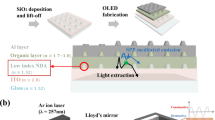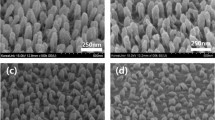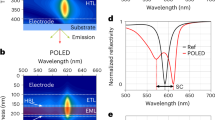Abstract
We demonstrate the highly effective extraction of waveguided light from the active region of organic light-emitting devices using a non-diffractive dielectric grid layer placed between the transparent anode and the substrate. The sub-anode grid couples out all waveguide mode power into the substrate without changing the device electrical properties, resulting in an increase in both the external quantum efficiency and luminous efficacy for green phosphorescent organic light-emitting devices from 15 ± 1% and 36 ± 2 lm W–1 to 18 ± 1% and 43 ± 2 lm W–1. These characteristics are further increased to 40 ± 2% and 95 ± 4 lm W–1 when all glass modes are also extracted. The use of a thick electron transport layer further reduces surface plasmon modes, resulting in an increase in the substrate and air modes by 50 ± 8% compared with devices lacking the grids. The sub-anode grid has minimal impact on organic light-emitting device emission wavelength and viewing angle, and is likely to prove beneficial for a broad range of display and lighting applications.
This is a preview of subscription content, access via your institution
Access options
Subscribe to this journal
Receive 12 print issues and online access
$209.00 per year
only $17.42 per issue
Buy this article
- Purchase on Springer Link
- Instant access to full article PDF
Prices may be subject to local taxes which are calculated during checkout






Similar content being viewed by others
References
Adachi, C., Baldo, M. A., Thompson, M. E. & Forrest, S. R. Nearly 100% internal phosphorescence efficiency in an organic light-emitting device. J. Appl. Phys. 90, 5048–5051 (2001).
Baldo, M. A. et al. Highly efficient phosphorescent emission from organic electroluminescent devices. Nature 395, 151–154 (1998).
Chutinan, A., Ishihara, K., Asano, T., Fujita, M. & Noda, S. Theoretical analysis on light-extraction efficiency of organic light-emitting diodes using FDTD and mode-expansion methods. Org. Electron. 6, 3–9 (2005).
Bulović, V. et al. Weak microcavity effects in organic light-emitting devices. Phys. Rev. B 58, 3730–3740 (1998).
Smith, L. H., Wasey, J. A. E., Samuel, I. D. W. & Barnes, W. L. Light out-coupling efficiencies of organic light-emitting diode structures and the effect of photoluminescence quantum yield. Adv. Funct. Mater. 15, 1839–1844 (2005).
Nowy, S., Krummacher, B. C., Frischeisen, J., Reinke, N. A. & Brütting, W. Light extraction and optical loss mechanisms in organic light-emitting diodes: Influence of the emitter quantum efficiency. J. Appl. Phys. 104, 123109 (2008).
Möller, S. & Forrest, S. R. Improved light out-coupling in organic light emitting diodes employing ordered microlens arrays. J. Appl. Phys. 91, 3324 (2002).
Sun, Y. & Forrest, S. R. Organic light emitting devices with enhanced outcoupling via microlenses fabricated by imprint lithography. J. Appl. Phys. 100, 073106 (2006).
Yamasaki, T., Sumioka, K. & Tsutsui, T. Organic light-emitting device with an ordered monolayer of silica microspheres as a scattering medium. Appl. Phys. Lett. 76, 1243–1245 (2000).
Do, Y. R. et al. Enhanced light extraction from organic light-emitting biodes with 2D SiO2/SiNx photonic crystals. Adv. Mater. 15, 1214–1218 (2003).
Bocksrocker, T. et al. White organic light emitting diodes with enhanced internal and external outcoupling for ultra-efficient light extraction and Lambertian emission. Opt. Express 20, A932–A940 (2012).
Mladenovski, S., Neyts, K., Pavicic, D., Werner, A. & Rothe, C. Exceptionally efficient organic light emitting devices using high refractive index substrates. Opt. Express 17, 7562–7570 (2009).
Nakamura, T., Tsutsumi, N., Juni, N. & Fujii, H. Thin-film waveguiding mode light extraction in organic electroluminescent device using high refractive index substrate. J. Appl. Phys. 97, 054505 (2005).
Lee, S.-J. & Cooper, J. Estimating regional material flows for LCDs. Proceedings of the IEEE International Symposium on Electronics and the Environment 2008 (ISEE 2008). 1–6 (2008).
Sun, Y. & Forrest, S. R. Enhanced light out-coupling of organic light-emitting devices using embedded low-index grids. Nature Photon. 2, 483–487 (2008).
Slootsky, M. & Forrest, S. R. Enhancing waveguided light extraction in organic LEDs using an ultra-low-index grid. 35, 1052–1054 (2010).
Koo, W. H. et al. Light extraction from organic light-emitting diodes enhanced by spontaneously formed buckles. Nature Photon. 4, 222–226 (2010).
Chang, H.-W. et al. Nano-particle based scattering layers for optical efficiency enhancement of organic light-emitting diodes and organic solar cells. J. Appl. Phys. 113, 204502 (2013).
Chang, H.-W. et al. Organic light-emitting devices integrated with internal scattering layers for enhancing optical out-coupling. J. Soc. Inf. Disp. 19, 196–204 (2011).
Schmidt, T. D. et al. Evidence for non-isotropic emitter orientation in a red phosphorescent organic light-emitting diode and its implications for determining the emitter's radiative quantum efficiency. Appl. Phys. Lett. 99, 163302 (2011).
Flämmich, M. et al. Oriented phosphorescent emitters boost OLED efficiency. 12, 1663–1668 (2011).
Frischeisen, J., Yokoyama, D., Adachi, C. & Brütting, W. Determination of molecular dipole orientation in doped fluorescent organic thin films by photoluminescence measurements. Appl. Phys. Lett. 96, 073302 (2010).
Computer program COMSOL Multiphysics (COMSOL AB, 2013).
Slootsky, M. & Forrest, S. R. Full-wave simulation of enhanced outcoupling of organic light-emitting devices with an embedded low-index grid. Appl. Phys. Lett. 94, 163302 (2009).
Celebi, K., Heidel, T. & Baldo, M. Simplified calculation of dipole energy transport in a multilayer stack using dyadic Green's functions. Opt. Express 15, 327–334 (2007).
Chance, R. R., Prock, A. & Silbey, R. in Advances in Chemical Physics Vol. 37 (eds, Prigogini, I. & Rice, S. A.) 1–65 (Wiley, 2007).
Chance, R. R., Prock, A. & Silbey, R. Lifetime of an emitting molecule near a partially reflecting surface. J. Chem. Phys. 60, 2744 (1974).
D'Andrade, B. W. & Forrest, S. R. White organic light-emitting devices for solid-state lighting. Adv. Mater. 16, 1585–1595 (2004).
Sun, Y. et al. Management of singlet and triplet excitons for efficient white organic light-emitting devices. Nature 440, 908–912 (2006).
Brütting, W., Frischeisen, J., Schmidt, T. D., Scholz, B. J. & Mayr, C. Device efficiency of organic light-emitting diodes: progress by improved light outcoupling. Phys. Status Solidi 210, 44–65 (2013).
Hobson, P. A., Wasey, J. A. E., Sage, I. & Barnes, W. L. The role of surface plasmons in organic light-emitting diodes. IEEE J. Sel. Top. Quantum Electron. 8, 378–386 (2002).
Wang, H. Y., Foote, R. S., Jacobson, S. C., Schneibel, J. H. & Ramsey, J. M. Low temperature bonding for microfabrication of chemical analysis devices. Sens. Actuat. B 45, 199–207 (1997).
Forrest, S. R., Bradley, D. D. C. & Thompson, M. E. Measuring the efficiency of organic light-emitting devices. Adv. Mater. 15, 1043–1048 (2003).
Acknowledgements
The authors thank K. Lee for discussions. The authors acknowledge financial support from Universal Display Corporation. This work was performed in part at the Lurie Nanofabrication Facility, a member of the National Nanotechnology Infrastructure Network, which is supported in part by the National Science Foundation.
Author information
Authors and Affiliations
Contributions
Y.Q. performed simulations, fabrication of the PHOLEDs, measurements and data analysis. M.S. designed the sub-anode grid and performed simulations, fabrication and AFM image scans. S.R.F directed the research project and analysed results. All authors discussed the results and contributed to the manuscript.
Corresponding author
Ethics declarations
Competing interests
One of the authors (S.R.F.) has a small equity interest in one of the sponsors of this research (Universal Display Corporation).
Rights and permissions
About this article
Cite this article
Qu, Y., Slootsky, M. & Forrest, S. Enhanced light extraction from organic light-emitting devices using a sub-anode grid. Nature Photon 9, 758–763 (2015). https://doi.org/10.1038/nphoton.2015.194
Received:
Accepted:
Published:
Issue Date:
DOI: https://doi.org/10.1038/nphoton.2015.194
This article is cited by
-
Cavity-Suppressing Electrode Integrated with Multi-Quantum Well Emitter: A Universal Approach Toward High-Performance Blue TADF Top Emission OLED
Nano-Micro Letters (2022)
-
Efficient and stable organic light-emitting devices employing phosphorescent molecular aggregates
Nature Photonics (2021)
-
Tailor-made nanostructures bridging chaos and order for highly efficient white organic light-emitting diodes
Nature Communications (2019)
-
Simple and scalable growth of AgCl nanorods by plasma-assisted strain relaxation on flexible polymer substrates
Nature Communications (2017)
-
Ultrasonic spray coating polymer and small molecular organic film for organic light-emitting devices
Scientific Reports (2016)



